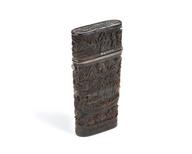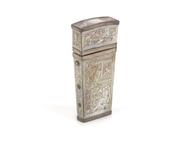

‘Hodge No 5’ supportive pessary, United Kingdom, 1870-1930
- Made:
- 1870-1930 in United Kingdom

Pessary, supportive, Hodge No.5, vulcanite, British, 1870 to 1930
Hugh Lennox Hodge invented this pessary in 1866. It supported a prolapsed uterus. This is where the uterus has shifted down from its usual position in the abdominal cavity. The use of pessaries became widespread in the 1800s. One American physician complained there were so many variations in design, ‘the uterus could justly complain that it was always being impaled upon a stem or perched on a twig,’ but it ‘certainly could not complain there was want in variety of the stem or monotony in the contour of the twig.’ The Hodge pessary is still used.
Details
- Category:
- Therapeutics
- Collection:
- Sir Henry Wellcome's Museum Collection
- Object Number:
- A612468
- Materials:
- vulcanite
- Measurements:
-
overall: 34 mm x 190 mm x 50 mm, 0.02kg
- type:
- pessary




